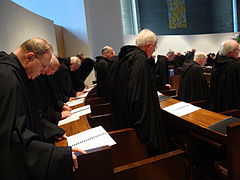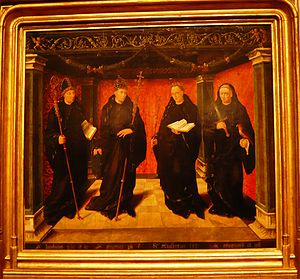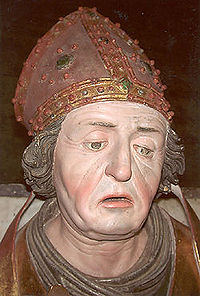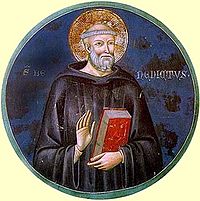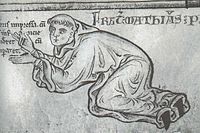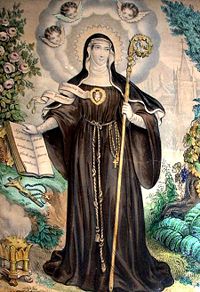- Order of Saint Benedict
-
For the article on Orthodox Benedictines, see Order of Saint Benedict (Orthodox). For the Anglican order of the same name, see Order of St. Benedict (Anglican).
- This article concerns Roman Catholic Order of Saint Benedict; see also Benedictine Confederation and Benedictine.
Order of Saint Benedict 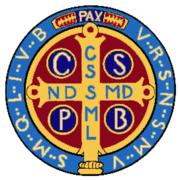
Abbreviation Benedictines Formation 910 Type Catholic religious order Headquarters Benedictine Confederation governs the autonomous union of houses Founder Benedict of Nursia Website OSB-International The Order of Saint Benedict (Latin name: Ordo Sancti Benedicti) is a Roman Catholic religious order of independent monastic communities that observe the Rule of St. Benedict. Within the order, each individual community (which may be a monastery, a priory or abbey) maintains its own autonomy, while the organization as a whole exists to represent their mutual interests. Today the terms "Order of St Benedict" and "Benedictine Order" are also used frequently to refer to the total of the independent Benedictine abbeys, thereby giving the wrong impression of a "generalate" or "motherhouse" with jurisdiction over dependent communities. The Benedictine Confederation, which was established in 1883 by Pope Leo XIII in his brief Summum semper, is the international governing body of the order, headed by the Abbot Primate.
Contents
Historical development
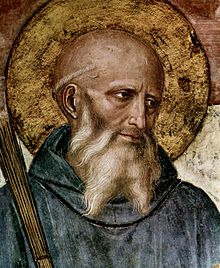 St Benedict of Nursia (c. 480-543), detail from a fresco by Fra Angelico, San Marco, Florence (c. 1400-1455).
St Benedict of Nursia (c. 480-543), detail from a fresco by Fra Angelico, San Marco, Florence (c. 1400-1455).
The monastery at Subiaco established in Italy by St. Benedict of Nursia circa 529 was the first of a dozen monasteries founded by him. Even so, there is no evidence to suggest that he intended to found an order. To the contrary, the Rule of St Benedict presupposes the autonomy of each community. Despite the absence of a Benedictine order, since most monasteries founded during the Middle Ages adopted the Rule of St Benedict, it became the standard for Western Monasticism.
The Benedictine monasteries went on to make considerable contributions not only to the monastic and the spiritual life of the West, but also to economics, education, and government, so that the years from 550 to 1150 may be called the "Benedictine centuries".
Even today Benedictine monasticism is fundamentally different from other Western religious orders insofar as its individual communities are not part of a religious order with "Generalates" and "Superiors General". Rather, in modern times, the various autonomous houses have formed themselves loosely into congregations (for example, Cassinese, English, Solesmes, Subiaco, Camaldolese, Sylvestrines) that in turn are represented in the Benedictine Confederation that came into existence through Pope Leo XIII's Apostolic Brief "Summum semper" on July 12, 1883. This organization facilitates dialogue of Benedictine communities with each other and the relationship between Benedictine communities and other religious orders and the church at large.
The Rule of Saint Benedict is also used by a number of religious orders that began as reforms of the Benedictine tradition such as the Cistercians and Trappists although none of these groups are part of the Benedictine Confederation.
The largest number of Benedictines are Roman Catholics, but there are also some within the Anglican Communion and occasionally within other Christian denominations as well, for example, within the Lutheran Church.
Benedictine vow and life
The Rule of St Benedict (ch. 58.17) requires candidates for reception into a Benedictine community to promise solemnly stability (to remain in the same monastery), conversatio morum (an idiomatic Latin phrase suggesting "conversion of manners"), and obedience (to the superior, because the superior holds the place of Christ in their community). This solemn commitment tends to be referred to as the "Benedictine vow" and is the Benedictine antecedent and equivalent of the evangelical counsels professed by candidates for reception into a religious order. Much scholarship over the last 50 years has been dedicated to the translation of conversatio morum. The older translation "conversion of life" has generally been replaced with phrases such as "a monastic manner of life," drawing from the Vulgate's use of conversatio as the translation of "citizenship" in Philippians 3:22. Some scholars have claimed that the vow formula of the Rule is best translated as "to live in this place as a monk, in obedience to its rule and abbot."
Benedictine abbots and abbesses have full jurisdiction of their abbey and thus absolute authority over the monks or nuns who are resident. This authority includes the power to assign duties, to decide which books may or may not be read, to regulate comings and goings, and to punish and excommunicate.[citation needed]
A tight communal timetable (horarium) is meant to ensure that the time given by God is not wasted but in whichever way necessary used in his service, whether for prayer, work, meals, spiritual reading, sleep.
Although Benedictines do not take a vow of silence, hours of strict silence are set, and at other time silence is maintained as much as is practically possible. Social conversations tend to be limited to communal recreation times. But such details, like many others details of the daily routine of a Benedictine house that the Rule of St Benedict leaves to the discretion of the superior, are set out in its customary.
In the Roman Catholic Church according to the norms of the Code of Canon Law 1983 a Benedictine abbey is a "Religious Institute", and its professed members are therefore members of the "Consecrated Life", commonly referred to as "Religious". Benedictine monks who have not been ordained and all nuns are members of the laity among the Christian faithful. Only those Benedictine monks who have been ordained as a deacon or priest are also members of the clergy of the Roman Catholic Church. Benedictine Oblates endeavor to embrace the spirit of the Benedictine vow in their own life in the world.[1]
Famous Benedictines[2]
Saint Boniface (c680-750), Pope Gregory I (c540-604, r. 590-604), Adalbert of Egmond (8th century), and priest Jeroen van Noordwijk, depicted in a 1529 painting by Jan Joostsz van Hillegom, currently on display at the Frans Hals Museum.
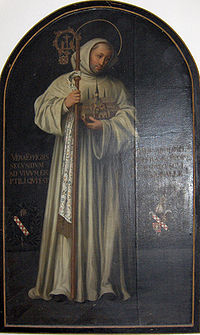 Bernard of Clairvaux (1090-1153), in a 1700 painting by Georg Andreas Wasshuber (1650-1732) on display at Heiligenkreuz Abbey.
Bernard of Clairvaux (1090-1153), in a 1700 painting by Georg Andreas Wasshuber (1650-1732) on display at Heiligenkreuz Abbey.
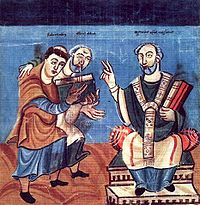 Rabanus Maurus (c780-856) (left), supported by Alcuin (c735-804) (middle), presents his work to Otgar of Mainz, from a Carolingian Manuscript, c840.
Rabanus Maurus (c780-856) (left), supported by Alcuin (c735-804) (middle), presents his work to Otgar of Mainz, from a Carolingian Manuscript, c840.
Popes
- Pope Gregory I (c540-604, r. 590-604)
- Pope Sylvester II (c946-1003, r. 999-1003)
- Pope Gregory VII (c1020-85, r. 1073-85)
- Pope Victor III (c1026-87, r. 1086-87)
- Pope Paschal II (d. 1118, r. 1099-1118)
- Pope Gelasius II (d. 1119, r. 1118-19)
- Pope Celestine V (1215-96, r. 1294)
- Pope Clement VI (1291-1352, r. 1342-52)
- Pope Urban V (1310-70, r. 1362-70)
- Pope Pius VII (1742-1823, r. 1800-23)
- Pope Gregory XVI (1765-1846, r. 1831-46)
Apostles and missionaries
- Augustine of Canterbury (d. 604)
- Saint Boniface (c680-755)
- Willibrord (c658-739)
- Suitbert of Kaiserwerdt (d. 713)
- Rupert of Salzburg (c660-710)
- Saint Sturm (c705-79)
- Ansgar (801-65)
- Adalbert of Prague (c956-97)
Founders of abbeys and congregations and prominent reformers
- Earconwald (c630-93)
- Benedict Biscop (c628-90)
- Benedict of Aniane (747-821)
- Dunstan (909-88)
- Berno of Cluny (c850-927)
- Odo of Cluny (c878-942)
- Majolus of Cluny (c906-94)
- Odilo of Cluny (c962-c1048)
- Bernard of Cluny (d. 1109)
- Peter the Venerable (c1092-1156)
- Romuald (c956-c1026)
- Robert of Molesme (c1028-1111)
- Alberic of Cîteaux (d. 1109)
- Stephen Harding (d. 1134)
- Bernard of Clairvaux (1090-1153)
- William of Hirsau (c1030-91)
- John Gualbert (995-1073)
- Stephen of Obazine (1084-1154)
- Robert of Arbrissel (c1045-1116)
- William of Montevergine (1085-1142)
- Sylvester Gozzolini (1177-1267)
- Bernardo Tolomei (1272-1348)
- Laurent Bénard (1573-1620)
- Prosper Guéranger (1805-75)
- Jean-Baptiste Muard (1809-54)
- Boniface Wimmer (1809-87)
- Martin Marty (1834-96)
Scholars, historians, and spiritual writers
- Bede (673-735)
- Aldhelm (c639-709)
- Alcuin (d. 804)
- Rabanus Maurus (c780-856)
- Paschasius Radbertus (785-865)
- Ratramnus (d. 866)
- Walafrid Strabo (c808-49)
- Notker Labeo (c950-1022)
- Guido of Arezzo (991-1050)
- Hermann of Reichenau (1013-54)
- Paul the Deacon (c720-99)
- Hincmar (806-82)
- Peter Damian (c1007-72)
- Lanfranc (c1005-89)
- Anselm of Canterbury (c1033-1109)
- Eadmer (c1060-c1126)
- Florence of Worcester (d. 1118)
- Symeon of Durham (d. 1130)
- Jocelyn de Brakelond (d. 1211)
- Matthew Paris (c1200-59)
- William of Malmesbury (c1095-c1143)
- Gervase of Canterbury (c1141-c1210)
- Roger of Wendover (d. 1236)
- Peter the Deacon (d. 1140)
- Adam Easton (d. 1397)
- John Lydgate (c1370-c1451)
- John Whethamstede (d. 1465)
- Johannes Trithemius (1462-1516)
- Louis de Blois (1506-66)
- Benedict van Haeften (1588-1648)
- Augustine Baker (1575-1641)
- Antoine Augustin Calmet (1672-1757)
- Magnoald Ziegelbauer (1689-1750)
- Marquard Herrgott (1694-1762)
- Suitbert Bæumer (1845-94)
- Luigi Tosti (1811-97)
- Jean Baptiste François Pitra (1812-89)
- Francis Aidan Gasquet (1846-1929)
- Fernand Cabrol (1855-1937)
- Germain Morin (1861-1946)
- John Chapman (1865-1933)
- Cuthbert Butler (1858-1934)
Maurists
- Nicolas-Hugues Ménard (1585-1644)
- Luc d'Achery (1609-85)
- Antoine-Joseph Mège (1625-91)
- Thierry Ruinart (1657-1709)
- François Lamy (1636-1711)
- Pierre Coustant (1654-1721)
- Edmond Martène (1654-1739)
- Ursin Durand (1682-1771)
- Bernard de Montfaucon (1655-1741)
- René-Prosper Tassin (1697-1777)
Bishops, monks, and martyrs
- Laurence of Canterbury (d. 619)
- Mellitus (d. 624)
- Justus (d. 627)
- Paulinus of York (d. 644)
- Oda of Canterbury (d. 958)
- Bertin (c615-c709)
- Wilfrid (c633-c709)
- Cuthbert (c634-87)
- John of Beverley (d. 721)
- Swithun (d. 862)
- Æthelwold of Winchester (d. 984)
- Edmund Rich (1175-1240)
- Abbot Suger (c1081-1151)
- John Beche (d. 1539)
- Richard Whiting (d. 1539)
- Hugh Cook Faringdon (d. 1539)
- Sigebert Buckley (c1520-c1610)
- Gabriel Gifford (1554-1629)
- Philip Michael Ellis (1652-1726)
- Charles Walmesley (1722-97)
- William Placid Morris (1794-1872)
- John Polding (1794-1877)
- William Bernard Ullathorne (1806-89)
- Roger Vaughan (1834-83)
- Guglielmo Sanfelice d'Acquavilla (1834-97)
- Joseph Pothier (1835-1923)
- John Cuthbert Hedley (1837-1915)
- Domenico Serafini (1852-1918)
Nuns
- Scholastica (c480-547)
- Æthelthryth (c636-79)
- Hilda of Whitby (c614-80)
- Werburh (d. 699)
- Mildthryth (d. early 7th century)
- Saint Walpurga (c710-79)
- Hildegard of Bingen (1098-1179)
- Gertrude the Great (1256-c1302)
- Frances of Rome (1384-1440)
See also
- Abbey of Cluny, an abbey, reformed during the Middle Ages, strictly adhering to the Rule.
- Ampleforth Abbey
- Camaldolese
- Downside Abbey
- Ealing Abbey
- Isen Abbey
- Melk Abbey
- Olivetans
- Sylvestrines
- Trappists
- Pontifical Congregation of the Benedictine Sisters of the Reparation of the Holy Face
- Saint Anselm Abbey
- Saint Anselm College[3]
- St. Benedict Abbey (Still River, MA)
- Selby Abbey
- Worth Abbey
- Westminster Abbey 12th Century (Original Abbey)
References
- ^ "928". Catechism of the Catholic Church. http://www.scborromeo.org/ccc/p123a9p4.htm#III. Retrieved 2009-07-11.
- ^ Based on List from Catholic Encyclopedia
- ^ Saint Anselm College
- Attribution
 This article incorporates text from a publication now in the public domain: Herbermann, Charles, ed (1913). "The Benedictine Order". Catholic Encyclopedia. Robert Appleton Company.
This article incorporates text from a publication now in the public domain: Herbermann, Charles, ed (1913). "The Benedictine Order". Catholic Encyclopedia. Robert Appleton Company.External
Reading
- Dom Columba Marmion OSB, Christ the Ideal of the Monk – Spiritual Conferences on the Monastic and Religious Life (Engl. edition London 1926, trsl. from the French by a nun of Tyburn Convent).
- Mariano Dell'Omo, Storia del monachesimo occidentale dal medioevo all'età contemporanea. Il carisma di san Benedetto tra VI e XX secolo. Jaca Book, Milano 2011. ISBN 978-88-16-30493-2
Links
Categories:- Benedictine
- Catholic spirituality
- Institutes of Consecrated Life
Wikimedia Foundation. 2010.

